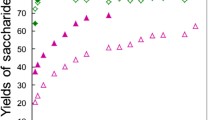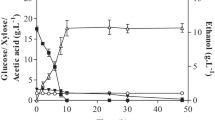Abstract
Ethanol has drawn attention worldwide to be a true alternative of fossil fuel due to its renewable nature and economics. In the present study, we aimed to evaluate a cheaper and abundantly available wild species of sugarcane, Saccharum spontaneum, as the raw substrate for ethanol production under simultaneous saccharification and fermentation (SSF) conditions. The substrate was first pretreated with aqueous ammonia followed by enzymatic hydrolysis coupled with the fermentation of released sugars into ethanol by monoculture as well as mixed cultures of thermotolerant S. cerevisiae VS3 and P. stipitis NCIM 3498. The cellulase enzyme used for saccharification was prepared from the culture supernatants of Aspergillus oryzae MTCC1846 grown under submerged fermentation conditions. A maximum of 0.85 ± 0.07 IU/mL of filter paperase (FPase), 1.25 ± 0.04 IU/mL of carboxy methyl cellulase (CMCase) and 55.56 ± 0.52 IU/mL of xylanase activity was obtained after 7 days of incubation using delignified S. spontaneum as carbon source under submerged fermentation conditions. During SSF, P. stipitis, VS3 and mixed culture showed ethanol production-15.73±0.44 g/l (productivity, 0.218±0.04 g/l/h), 14.22±0.15 g/l (productivity, 0.197±0.02 g/l/h) and 17.73 ± 0.25 g/l (productivity, 0.246 ± 0.02 g/l/h), respectively.
Similar content being viewed by others
References
Ballesteros I, Ballesteros M, Cabanas A, Carrasco J, Martin C, Negro MJ, Saez F, Saez R (1991). Selection of thermotolerant yeasts for simultaneous saccharification and fermentation (SSF) of cellulose to ethanol. Appl. Biochem. Biotechnol. 8(29): 307–315.
Campbell CJ, Laherrere JH (1998). The end of cheap oil. Sci. Am. 3:78–83.
Chandel AK, Chan EC, Rudravaram R, Narasu ML, Rao LV, Ravindra P (2007a). Economics and environmental impact of bioethanol production technologies: an appraisal. Biotechnol. Mol. Biol. Rev. 2: 14–32.
Chandel AK, Kapoor RK, Narasu ML, Viswadevan V, Kumaran SSG, Ravinder R, Rao LV, Tripathi KK, Lal B, Kuhad RC (2007b). Economic evaluation and environmental benefits of biofuel: an Indian perspective. Int. J. Global Ener. Issues. 28: 357–381.
Chandel AK, Narasu ML, Chandrasekhar G, Manikeyam A, Rao LV (2009a). Use of Saccharum spontaneum (wild sugarcane) as biomaterial for cell immobilization and modulated ethanol production by thermotolerant Saccharomyces cerevisiae VS3. Biores. Technol. 100: 2404–2410.
Chandel AK, Narasu ML, Rudravaram R, Ravindra P, Narasu ML, Rao LV (2009b). Bioconversion of de-oiled rice bran (DORB) hemicellulosic hydrolysate into ethanol by Pichia stipitis NCIM3498 under optimized conditions. Int. J. Food Eng. 4: 1–12.
Eklund R, Zacchi G (1995). Simultaneous saccharification and fermentation of steam-pretreated willow. Enzyme Microb. Technol. 17: 55–259.
Kim HT, Kim JS, Sunwoo C, Lee YY (2008). Pretreatment of corn stover by aqueous ammonia. Biores. Technol. 90: 39–47.
Krishna SH, Reddy TJ, Chowdary GV (2001). Simultaneous saccharification and fermentation of lignocellulosic wastes to ethanol using thermotolerant yeast. Biores. Technol. 77: 193–196.
Linde M, Galbe M, Zacchi G (2007). Simultaneous saccharification and fermentation of steam-pretreated barley straw at low enzyme loadings and low yeast concentration. Enzyme Microb. Technol. 40: 1100–1107.
Lynd LR, Laser MS, Bransby D, Dale BE, Davison B, Hamilton R, Himmel M, Keller M, McMillan JD, Sheehan J, Wyman CE (2008). How biotech can transform biofuels. Nat. Biotechnol. 26: 169–172.
Mandels M (1985). Applications of cellulases. Biochem. Soc. Trans. 13: 414–415.
Minjares-Cassanco A, Trejor-Aguillas BA, Aguilar G (1997). Physiological comparison between pectinase producing mutants of Aspergillus niger adopted either to solid state fermentation or submerged fermentation. Enzyme Microb. Technol. 21: 26–27.
Martinez A, Rodriguez ME, York SW, Preston JF, Ingram LO (2000). Effects of Ca(OH)2 treatments (“overliming”) on the composition and toxicity of bagasse hemicellulose hydrolysates. Biotechnol. Bioeng. 69: 526–536.
Miller GL (1959). Use of dinitrosalicylic acid reagent for determination of reducing sugars. Anal. Chem. 31: 426–428.
Moiser N, Wyman C, Dale B, Elander R, Lee YY, Holtzapple M, Ladisch M (2005). Features of promising technologies for pretreatment of lignocellulosic biomass. Biores. Technol. 96: 673–686.
Nigam JN (2002). Bioconversion of water-hyacinth (Eichhornia crassipes) hemicellulose acid hydrolysate to motor fuel ethanol by xylose-fermenting yeast. J. Biotechnol. 97:107–116.
Ohgren K, Rudolf A, Galbe M, Zacchi G (2006). Fuel ethanol production from steam-pretreated corn stover using SSF at higher dry matter content. Biomass Bioenergy. 30: 863–869.
Olofsson K, Rudolf A, Lidén G (2008). Designing simultaneous saccharification and fermentation for improved xylose conversion by a recombinant strain of Saccharomyces cerevisiae. J. Biotechnol. 134: 112–120.
Pasha C, Valli N, Rao LV (2006). Lantana camara for fuel ethanol production using thermotolerant yeast. Lett. Appl. Microbiol. 44:666–672.
Puppan D (2002). Environmental evaluation of biofuels. Period Polytech. Ser. Soc. Man. Sci. 10: 95–116.
Rudolf A, Alkasrawi M, Zacchi G, Lidén G (2005). A comparison between batch and fed-batch simultaneous saccharification and fermentation of steam pretreated spruce. Enzyme Microb. Technol. 37: 195–205.
Sassner P, Galbe M, Zacchi G (2006). Bioethanol production based on simultaneous saccharification and fermentation of steampretreated Salix at high dry-matter content. Enzyme Microb. Technol. 39:756–762.
Sastri CST, Kavathekar KY (1990). Plants for Reclamation of Wastelands. Pbl. CSIR, New Delhi, India. 360–362.
Singleton VL, Orthofer R, Lamuela-Raventos RM (1999). Analysis of Total Phenols and Other Oxidation Substrates and Antioxidants by Means of Folin Ciocalteu Reagent. Methods Enzymol. 299: 152–178.
Söderström J, Galbe M, Zacchi G (2005). Separate versus simultaneous saccharification and fermentation of two-step pretreated softwood for ethanol production. J. Wood Chem. Technol. 25:187–202.
Sree KN, Sridhar M, Suresh K, Banat IM, Rao LV (2000). Isolation of thermotolerant, osmotolerant, flocculating Saccharomyces cerevisiae for ethanol production. Biores. Technol. 72: 43–46.
Sreenath HK, Koegel RG, Moldes AB, Jeffries TW, Straub RJ (2001). Ethanol production from alfalfa fiber fractions by saccharification and fermentation. Proc. Biochem. 36: 1199–1204.
Sukumaran RK, Singhania RR, Pandey A (2005). Microbial cellulases- Production, applications and challenges. J. Sci. Ind. Res. 64: 832–844.
Takagi M, Abe S, Suzuki S, Emert GH, Yata N (1977). A method for production of alcohol directly from cellulose using cellulase and yeast. In: Ghose, T.K. (Ed.), Proceedings of Bioconversion of Cellulosic Substances into Energy, Chemicals and Microbial Protein, IIT, New Delhi. 551–571.
Technical Association of the Pulp and Paper Institute (TAPPI), test methods, Georgia, USA, 1992.
Wyman CE (2007). What is (and is not) vital to advancing cellulosic ethanol. Trends Biotechnol. 25: 153–157.
Author information
Authors and Affiliations
Corresponding author
Rights and permissions
About this article
Cite this article
Chandel, A.K., Chandrasekhar, G., Lakshmi Narasu, M. et al. Simultaneous saccharification and fermentation (SSF) of aqueous ammonia pretreated Saccharum spontaneum (wild sugarcane) for second generation ethanol production. Sugar Tech 12, 125–132 (2010). https://doi.org/10.1007/s12355-010-0025-5
Received:
Revised:
Accepted:
Published:
Issue Date:
DOI: https://doi.org/10.1007/s12355-010-0025-5




